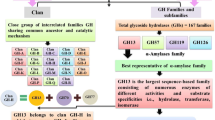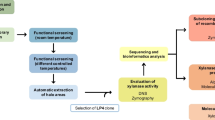Abstract
Ten xylanase isoforms produced by Myceliophthora sp. were characterized for their ability to bind to avicel. Three of the xylanases showing differential affinity for avicel were purified by column chromatography. The purified xylanase Xyl IIa, IIb and IIc showed molecular mass of 47, 41 and 30 kDa and pI of ∼3.5, 4.8 and 5.2, respectively. Xyl IIa was optimally active at pH 8.0 and temperature 70 °C, while Xyl IIb and IIc were optimally active at pH 9.0 and 60 °C and 7.0 and 80 °C, respectively. Xyl IIa and Xyl IIb showed higher stability under alkaline conditions (pH 9.0) and retained 80% of the original activity upto 1 h and 3 h respectively, at 50 °C. All three purified iso-xylanases showed enhanced activities in presence of Na+, Mg2+, Mn2+ and K+ ions, whereas, Zn2+ and Cu2+ showed negative effect on Xyl IIa. The activity of Xyl IIa increased in presence of reducing agents DTT and mercaptoethanol, however, SDS showed inhibitory effect. Kinetic studies showed that Xyl IIb and IIc degrade rye arabinoxylan, much more efficiently than oat spelt xylan, whereas, Xyl IIa showed much higher Kcat/Km value for birch wood xylan as compared to oat spelt xylan. The purified xylanases were apparently classified in family 10.







Similar content being viewed by others
References
Badhan AK, Chadha BS, Kaur J, Saini HS, Bhat MK (2007) Production of xylanolytic and cellulolytic enzymes by thermophilic fungus Myceliophthora sp. IMI 387099. Bioresour Technol 98:504–510
Badhan AK, Chadha BS, Sonia KG, Saini HS, Bhat MK (2004) Functionally diverse multiple xylanases of thermophilic fungus Myceliophthora sp. IMI 387099. Enzyme Microb Technol 35:460–466
Bennett NA, Ryan J, Biely P, Vrsanska M, Kremnicky L, Macris BJ, Kekos D, Christakopoulos P, Katapodis P, Claeyssens M, Nerinckx W, Ntauma P, Bhat MK (1998) Biochemical and catalytic properties of an endoxylanases purified from the culture filtrate of Thermomyces lanuginosus ATCC 46882. Carbohydr Res 306:445–455
Biely P (2003) Diversity of microbial endo-β-1,4-xylanase. In: Mansfield SD, Sadler JN (eds) Applications of enzymes to lignocellulosics. American chemical Society, Washington, p 361
Biely P, Vrasanska M, Tenkanen M, Kluepfel D (1997) Endo- β -1,4-xylanase families: differences in catalytic properties. J Biotechnol 57:151–166
Black GW, Rixon JE, Clarke JH, Hazlewood GP, Ferreira LMA, Bolam DN, Gilbert HJ (1997) Cellulose binding domains and linker sequences potentiate the activity of hemicellulases against complex substrates. J Biotechnol 57:59–67
Chadha BS, Badhan AK, Mellon F, Bhat MK (2004) Two endoxylanases active and stable at alkaline pH from the newly isolated thermophilic fungus, Myceliophthora sp. IMI 387099. J Biotechnol 109:227–237
Claeyssens M, Henrissat B (1992) Specificity mapping of cellulolytic enzymes: classification into families of structurally related protein confirmed by biochemical analysis. Protein Sci 1:1293–1297
Düsterhöff EM, Linssen VAJM, Voragen AGJ, Beldman G (1997) Purification, characterization and properties of two xylanases from Humicola insolens. Enzyme Microb Technol 20:437–443
Faulet BM, Niamke S, Gonnety JT, Kouame LP (2006) Purification and biochemical properties of a new thermostable xylanase for symbiotic fungus Termitomyces sp. Afr J Biotechnol 5:273–282
Ferreira LMA, Wood TM, Williamson G, Faulds C, Hazlewood GP, Gilbert HJ (1993) A modular esterase from Pseudomonas fluorescens sub sp. cellulosa contains a non-catalytic cellulose-binding domain. Biochem J 294:349–355
Fialho MB, Carmona EC (2004) Purification and characterization of xylanases from Aspergillus giganteus. Folia Microbiol 49:13–18
Franks N, Page KW (2002) Neutral deinking with a deinking composition comprising a lipase and a fatty acid ester. US patent 20020157798, 31 Oct 2002
Gilkes NR, Henrissat B, Kilburn DG, Miller RC Jr, Warren RA (1991) Domains in microbial β-1, 4-glycanases: sequence conservation, function, and enzyme families. Microbiol Rev 55:303–315
Ito S, Kuno A, Suzuki R, Kaneko S, Kawabata Y, Kusakabe I, Hasegawa T (2004) Rational affinity purification of native Streptomyces family 10 xylanase. J Biotechnol 110:137–142
Kalogeris E, Christakopoulos P, Kekos D, Macris BJ (1999) Mode of action of minor xylanase from Thermoascus aurantiacus on polysaccharides and model substrates. J Biosci Bioeng 87:819–821
Kaur J, Chadha BS, Badhan AK, Saini HS (2007) Purification and characterization of two endoglucanases from Melanocarpus sp. MTCC 3922. Bioresour Technol 98:74–81
Kulkarni N, Shendye A, Rao M (1999) Molecular and biotechnological aspects of xylanases. FEMS Microbiol Rev 23:411–456
Laemmli UK (1970) Cleavage of structural proteins during the assembly of the head of bacteriophage T4. Nature 227:680–685
Millward-Sadler D, Poole DM, Henrissat B, Hazlewood GP, Clarke JH, Gilbert HJ (1994) Evidence for a general role for high affinity non-catalytic cellulose binding domains in microbial plant cell wall hydrolases. Mol Microbiol 11:375–382
Ögel ZB, Yarangümeli K, Dündar H, Ifrij Ì (2001) Submerged cultivation of Scytalidium thermophilum on complex lignocellulosic biomass for endoglucanase production. Enzyme Microb Technol 28:689–695
Ohmiya Y, Takeda T, Nakamura S, Sakai F, Hayashi T (1995) Purification and properties of a wall-bound endo-1, 4-β-glucanase from suspension-cultured poplar cells. Plant Cell Physiol 36:607–614
Paradis FW, Zhu H, Krell PJ, Phillips JP, Forsberg CW (1993) The xynC gene from Fibrobacter succinogenes S85 codes for a xylanase with two similar catalytic domains. J Bacteriol 175:7666–7672
Romaniec MP, Fauth U, Kobayashi T, Huskisson NS, Barker PJ, Demain AL (1992) Purification and characterization of a new endoglucanase from Clostridium thermocellum. Biochem J 283:69–73
Rouvinen J, Bergfors T, Teeri T, Knowles JK, Jones TA (1990) Three-dimensional structure of cellobiohydrolase II from Trichoderma reesei. Science 249:380–386
Sakka K, Kojima Y, Kondo T, Karita S, Ohmiya K, Shimada K (1993) Nucleotide sequence of Clostridium stercorarium xyn A gene encoding xylanase A: identification of catalytic and cellulose binding domains. Biosci Biotechnol Biochem 57:273–277
Sa- Pereira P, Costa-Ferreira H, Aires-Barros M (2003) A new look at xylanases: an overview of purification strategies. Mol Biotechnol 24:257–281
Schülein M (1997) Enzymatic properties of cellulases from Humicola insolens. J Biotechnol 57:71–81
Sethi B, Mishra S, Bisaria VS (1998) Adsorption characteristics of cellulases from a constitutive mutant of Trichoderma reesei. J Ferment Bioeng 86:233–235
Stalbrand H, Saloheimo A, Vehmaanpera J, Henrissat B, Penttila M (1995) Cloning and expression in Saccharomyces cerevisiae of a Trichoderma reesei β-mannanase gene containing a cellulose binding domain. Appl Environ Microbiol 61:1090–1097
Subramaniyan S, Prema P (2002) Biotechnology of microbial xylanases: enzymology molecular biology and application. Crit Rev Biotechnol 22:33–46
Acknowledgement
The financial support to BSC by Department of Biotechnology, Ministry of Science & Technology; Government of India is duly acknowledged.
Author information
Authors and Affiliations
Corresponding author
Rights and permissions
About this article
Cite this article
Badhan, A.K., Chadha, B.S. & Saini, H.S. Purification of the alkaliphilic xylanases from Myceliophthora sp. IMI 387099 using cellulose-binding domain as an affinity tag. World J Microbiol Biotechnol 24, 973–981 (2008). https://doi.org/10.1007/s11274-007-9561-x
Received:
Accepted:
Published:
Issue Date:
DOI: https://doi.org/10.1007/s11274-007-9561-x




